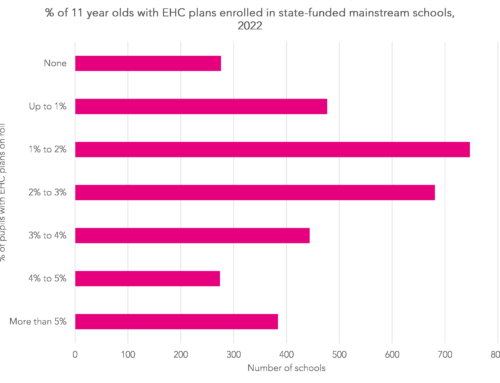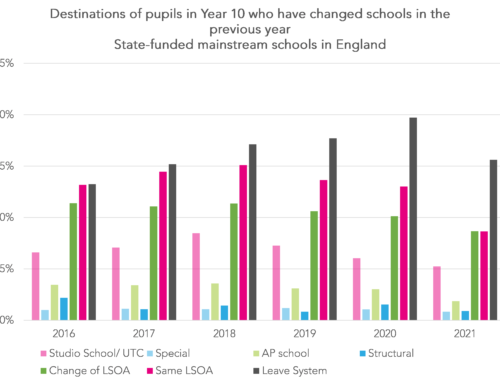ASCL have today called for oversubscribed schools to give greater priority to disadvantaged pupils when offering places.[1]
This is part of a series of measures proposed in their Blueprint for a Fairer Education System to reduce the attainment gap (reforms to SATs, GCSEs and the national curriculum are also included).
We’ve shown before that even if all schools closed their attainment gap, there would still be a national attainment gap.
This arises because disadvantaged pupils are disproportionately more likely to go to lower attaining schools.
It is this gap that the ASCL proposal addresses. But how far would it go?
The gap in 2019
By way of illustration, let’s go back to the gap in 2019. We’ll use the Attainment 8 measure for this.
The national gap between disadvantaged pupils and their peers in all state-funded schools was 13.6 percentage points:
- Disadvantaged pupils: 36.7
- Other pupils: 50.3
- Gap: 13.6
The percentage of disadvantaged pupils at each school varies considerably. Back in 2019, the range was 0% to 85%.
A thought experiment
So let’s imagine each school took an equal share of disadvantaged pupils. Let’s also imagine that the Attainment 8 scores of disadvantaged pupils and other pupils at each school was exactly the same as in 2019. These are shown in the chart below.

Around 77 mainstream schools, including a number of grammar schools, are not included due to having fewer than five disadvantaged pupils. Similarly, the majority of special schools tend to have small numbers of pupils. By necessity we have to exclude them from our analysis. So let’s recalculate the national gap excluding these schools.
- Disadvantaged pupils: 38.3
- Other pupils: 50.6
- Gap: 12.3
Now let’s recalculate the gap based on the even re-allocation of pupils.
- Disadvantaged pupils: 39.4
- Other pupils: 50.0
- Gap: 10.6
So the gap reduces by 1.7 points or around one seventh.
Summing up
If disadvantaged pupils had been re-allocated evenly across schools in 2019, and each school’s Attainment 8 scores for disadvantaged pupils and other pupils were unchanged, the national attainment gap would have reduced by around a fifth.
Obviously this would be worthwhile. But the attainment gap will not be closed until the attainment gaps within schools close. It is unclear how far this proposal, alone, would go towards achieving this aim.
How much of the attainment gap could schools realistically close? We have shown that the gap remains fairly constant over nursery and primary school and seems to widen during secondary education[2]. Perhaps the first step is to ensure this gap doesn’t widen.
[1] The school admissions code already allows schools to prioritise pupil premium students in their oversubscription criteria if they wish. ASCL’s propose to change this option into a requirement, similar to the existing arrangements for looked after children.
[2] The gap in nursery and primary is around 0.5 of a standard deviation, widening to around 0.67 of a standard deviation in secondary.





The attainment gap is the wrong focus, and only makes sense if the only influence on attainment is schools. Genes, intelligence, diet, sport, environment, peers and parenting all play a part. What we do in schools to improve learning is therefore bound to increase the attainment of the non disadvantaged more, and increase the gap. Instead, schools should focus on increasing progress and attainment for disadvantaged students and forget about the gap.
Just to be clear, Dominic, are you suggesting that genes influence the gap? If so, surely this would require some systematic genetic difference between disadvantaged children and non-disadvantaged children? Is there any evidence for such a genetic difference?
It’s no secret that home environments and other factors influence children’s attainment. But the gaps graphically expose a shameful inequality, which converts deprived children into deprived adults. Our society applies filters to children and people at every stage of their lives: it doesn’t matter how well you’ve done – it matters how well you’ve done relative to everyone else. Ignoring gaps means you will never know whether disadvantaged children are catching up. Intelligent analyses of the data, of the sort we see here, can shed light on issues which escape simple attention. So, yes, raising the attainment of disadvantaged children is vital. But if the attainment of other children rises at the same rate, the egregious inequality will remain. And you’ll know whether that’s the case only by monitoring the attainment of both groups i.e. the gaps.